About Khao Yai
Khao Yai is no doubt the best national park in Thailand for regular visitors where it is relatively easy to see some impressive animals.
Established in 1962 as Thailand's first national park, it is the third largest national park in Thailand. Situated mainly in Nakhon Ratchasima Province, Khao Yai extends into Prachinburi, Saraburi and Nakhon Nayok provinces. The main checkpoint of the park is 180 km from Bangkok.
The park covers an area of 2,168 km², including rain/evergreen forests and grasslands. 1,351 meters tall Khao Rom is the highest mountain within the park. The average altitude of the national park ranges from 400 to 1,000 meters asl.
Khao Yai is part of the Dong Phayayen-Khao Yai Forest Complex; a World Heritage Site declared by UNESCO, covering 5 protected areas from Khao Yai to Cambodian border. The other protected areas are; Pang Sida National Park, Thap Lan National Park, Ta Phraya National Park and Dong Yai Wildlife Sanctuary.
The rainy season is from May to October with high humidity and with the most rainfall in September. The rest of the year is quite dry. November to February are the winter months with cooler weather and average temperatures of 22 °C during the day and down to 9-10 °C during the night.
Wildlife
Mammals
Surely there are few other parks in the country with more impressive wildlife, but of the easily accessible national parks in Thailand, Khao Yai is no doubt the best option for mammal watching. Apart from Kui Buri National Park, Khao Yai is the next best park in the country where it is relatively easy to run into elephants with a bit of luck.
Some other often seen mammals include northern pig-tailed macaques, barking deer, sambar deer, gibbons, porcupines, civets. Other more elusive species seen from time to time are sun bears, Asian black bears, gaurs, otters, dholes and jackals.
The northern pig-tailed macaques sighting is a bit rare elsewhere in the country, they may easily be overlooked. Most tourists easily mix them up with the long-tailed macaques which are very common at many tourist destinations.
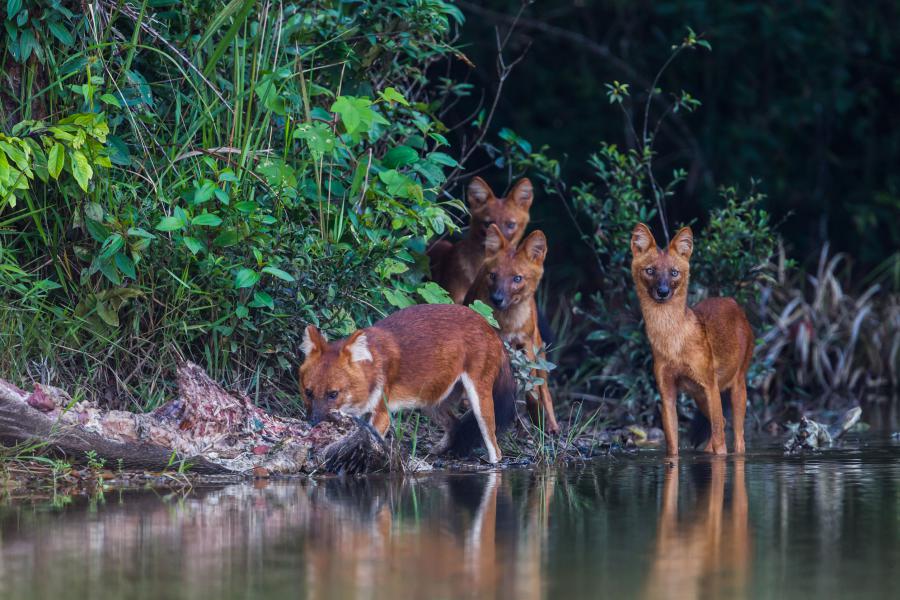
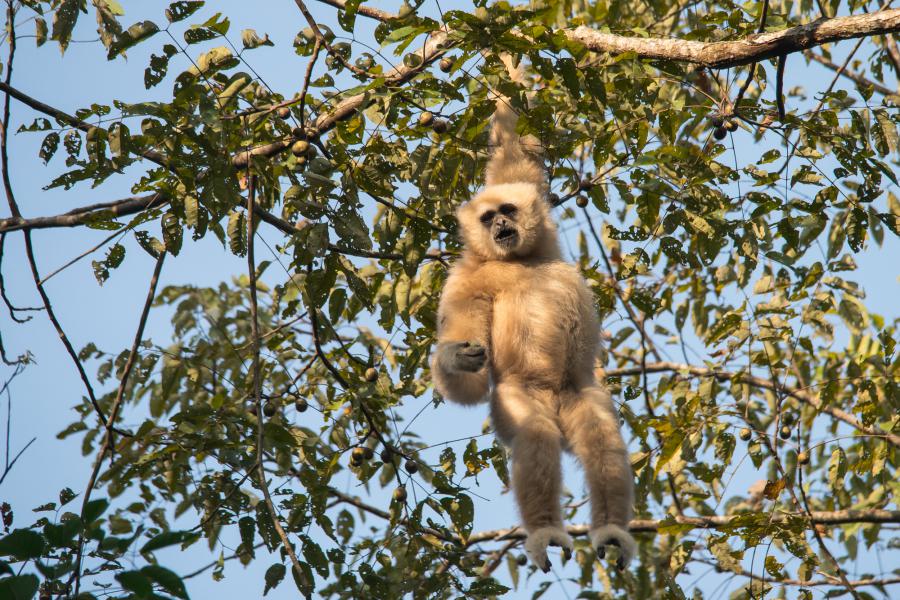
There hasn't been any sign of tiger activity in the park for a while, but camera traps have revealed a significant tiger population in the neighbouring Thap Lan and Pang Sida National Park. Recently, a wide wildlife passage has been built under a busy motorway east of Khao Yai, raising the hope that the tigers will be back to Khao Yai from Thap Lan one day.
Birds
Although some may be accidental records, around 440 bird species reported from Khao Yai. The park has one of the largest populations of hornbills in Thailand. Great hornbills and Oriental-pied hornbills can be seen flying over the visitor center area almost daily.
Rufous-tailed robins are a rare sighting in Thailand, only reported from Khao Yai National Park. Few other rare species are; Austen's brown hornbills, white-browed fantails, Blyth's pipits, greater adjutants, Japanese thrushes, coral-billed ground cuckoos and northern goshawks.
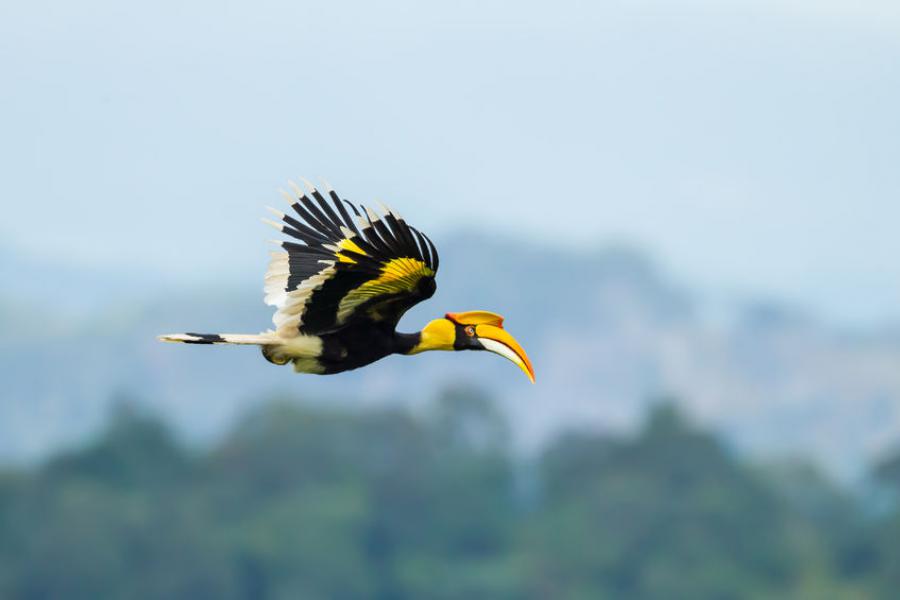
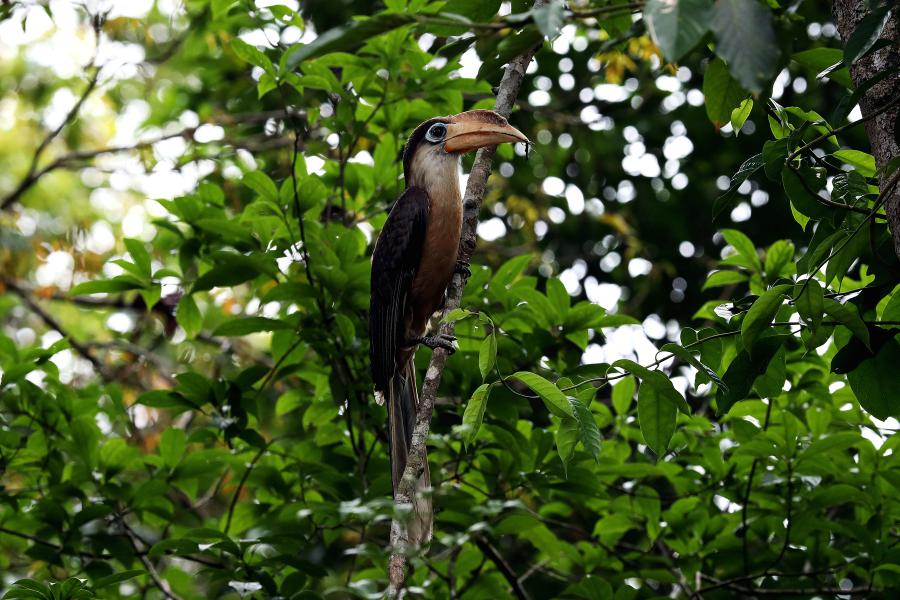
Junglefowls are wild chickens, very common and can be seen almost daily along the roads. Other relatively common ground dwelling birds like silver pheasants, scaly-breasted partridges and Siamese firebacks. Best time to visit Khao Yai for birdwatching is during the dry months and during March to April when the big bird migration to Thailand happens.
Reptiles
Khao Yai has also a very interesting reptile fauna, so far over 85 species recorded.
Of the pit viper three can be found in the park; Vogel’s pit vipers (Trimeresurus vogeli), large-eyed pit vipers (Trimeresurus macrops) and white-lipped pit vipers (trimeresurus-albolabris). Some of the rare snakes found in the park are Gibson's wolf snakes (Lycodon gibsonae), Nganson bronzebacks (Dendrelaphis ngansonensis) and Joynson's kukri snakes (Oligodon joynsoni). All three python species of Thailand have been recorded in Khao Yai National Park. Interestingly, several morphs of Oriental whip snake species are found in the park; white, brown and green, and they are the most encountered snake species in Khao Yai.
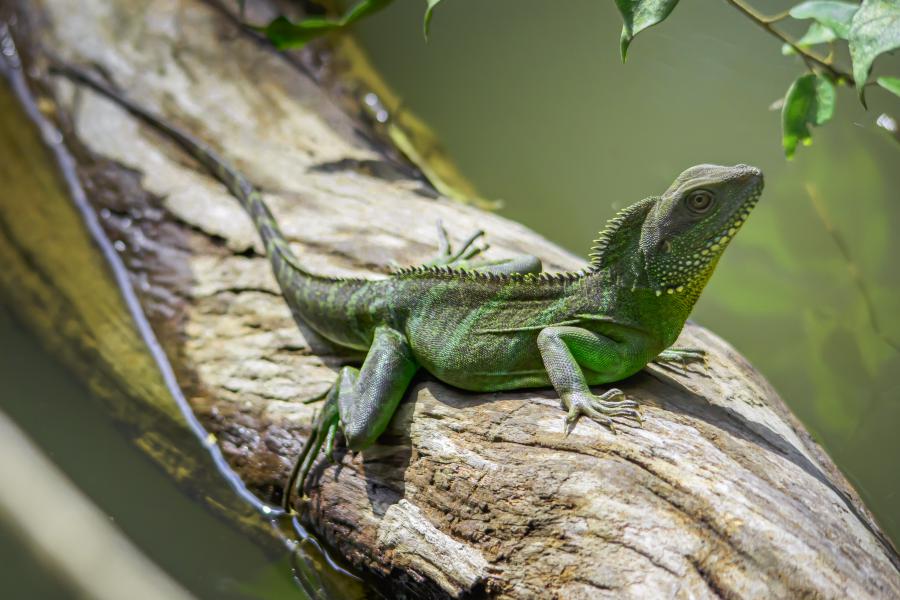
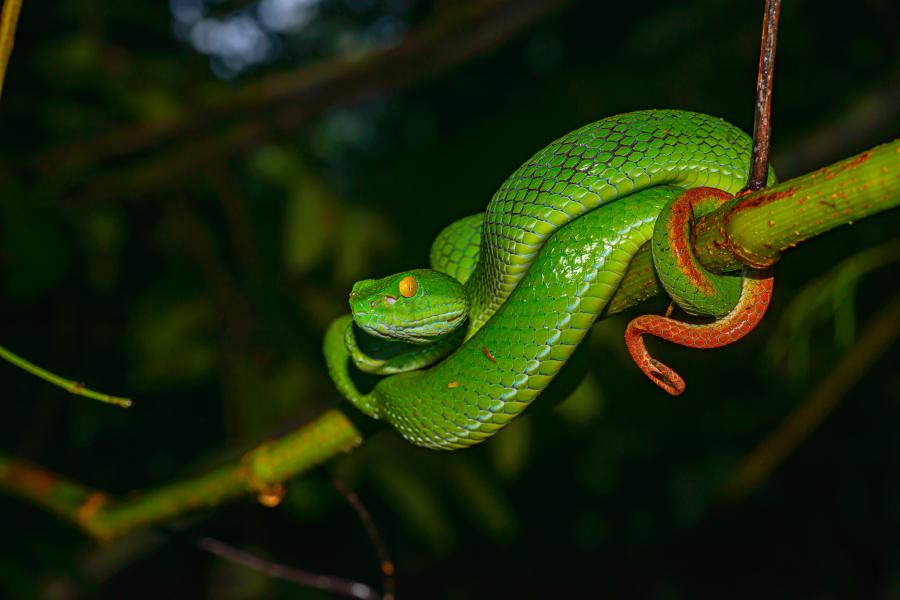
Chinese water dragons (Physignathus cocincinus) are a medium size lizard which can be found along the streams, the sighting is quite common. Some other interesting lizards found in the park are; Brown tree dragon (Acanthosaura lepidogaster), Cardamom tree dragons (Acanthosaura cardamomensis), Reeves's butterfly lizards (Leiolepis rubritaeniata), Cambodian stream skinks (Tropidophorus microlepis), Yunnan dwarf geckos (Hemiphyllodactylus yunnanensis), barred flying dragons (Draco taeniopterus) and spotted flying dragons (Draco maculatus). Reeves's butterfly lizards are often seen on grassland areas with a helipad, right south from the visitor center.
There used to be one single Siamese crocodile in the national park along one of the trails, but it is gone since a while back, presumably dead.
Getting there & get around
For planning reasons, it is good to know that the park is a very popular destination for both foreign and local tourists, it can be very busy on the week-ends and extremely busy on longer holidays.
The main entrance is at the north of the park with the nearest town being Pak Chong in Nakhon Ratchasima Province. The second entrance is at the south in Nakhon Nayok province.
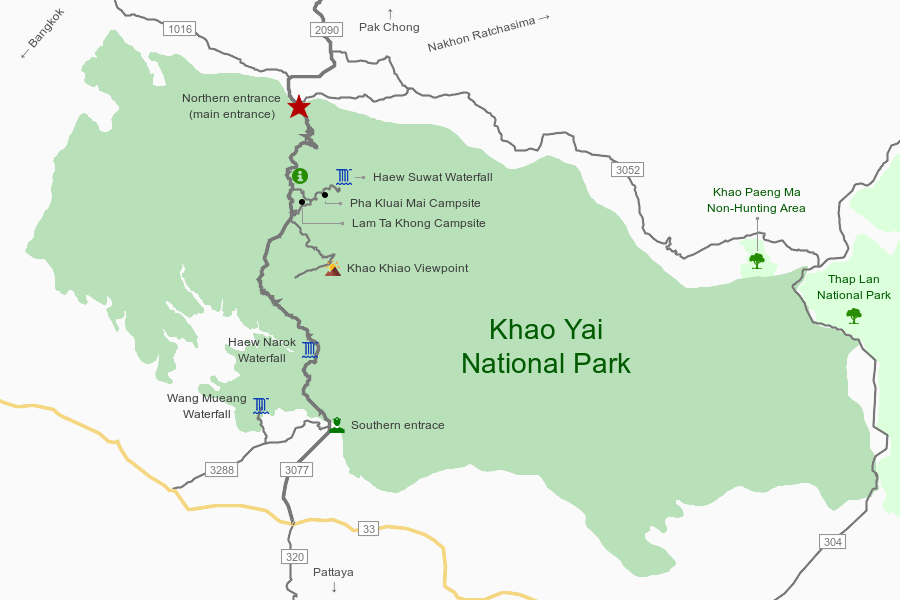
Get to Pak Chong or North Khao Yai
The main entry point to the park is in Pak Chong District, this is the area where most of the hotels are located right north of the entrance. In good traffic it takes around 2.5 hours to get to Khao Yai entrance area.
It is possible to get to certain spots north of Khao Yai with public transportation from Bangkok, but it could take up to 5-6 hours. The reason is; Buses depart from Mo Chit Bus Station which can take a bit of effort and time to get to, particularly during the rush hours. Once at the bus station, it takes a bit of time to purchase tickets and wait until the bus departs. Once reached Pak Chong, songthaews departs towards Khao Yai once an hour, but only when there are enough passengers, means another long wait could be ahead. Once reached north of Khao Yai, there are no public transportation options into the park. Add to that, not all hotels are along the road of songthaews reach, many can’t be walked to.
Get around in the park
It is not possible to enter the park by foot from the checkpoint. The visitor center is around 14 km further in and other popular attractions are much further inside the park. Good to know that even when reaching the visitor center area, the distances between popular attractions are too big to walk between. It is possible to hitchhike if there is enough traffic.
As of Nov 2019, there are still some 20 bicycles to rent from the visitor center but only 10 functional. The bikes won’t be available to rent if there is too much traffic inside the park. Generally the parks get too busy in week-ends and long holidays.
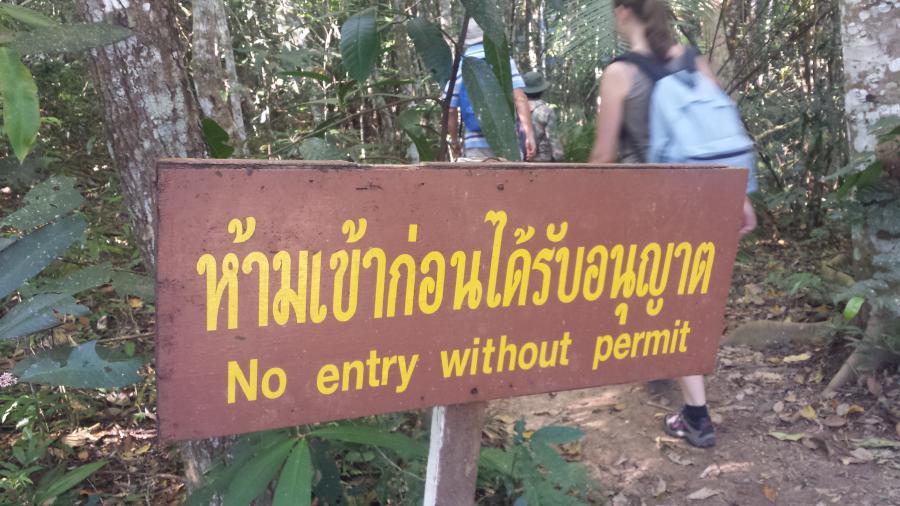
Visitors intending to explore the park on their own should be aware that it is not possible to walk longer trails without a guide. It is for a good reason; easy to get lost because this is a wild jungle with wild animals. It happens nearly every year that someone gets lost, and found either the same day or many days after. In a tragic incident in 2018, one Thai citizen lost his life. Searching “tourists lost in Khao Yai” on search engines will list a few incidents over the years that reached the media.
There are only a couple of trails that the tourists are allowed to walk freely; one is about 800 meters long circular trail behind the visitor center, the other is a recently opened Thai-American Friendship Trail not too far from the visitor center.
Two most popular waterfalls, two popular viewpoints and the visitor center can be accessed by car or bike and reached without any need of a guide, all not too far from their parking area. When planning, it is good to know that, from the moment of entering the park, to those 4 attractions and back to the checkpoint takes around 3 hours driving time, add to that the time to be spent at each spot to enjoy the scenery. It is not short distances with other words.
Wildlife tours
There are many tour operators and agencies offering tours into Khao Yai National Park. A tour doesn’t necessarily mean a wildlife tour, for this reason, it is important to know what type of tour you are after when visiting the park, good to make sure the guide you are getting is expert in local wildlife.
Many mainstream agencies offer cheap tours from Bangkok, these often only cover visiting of waterfalls, viewpoints, the vicinity of the visitor center and driving along the roads a bit.
The visitors interested in seeing wildlife or walking longer trails are recommended to book a wildlife tour with an experienced English speaking guide. A guided tour will make it possible to walk longer trails in the jungle and see more of the elusive animals.
Tour operators may not include pickup from hotels too far away from the park entrance. Also, some hotels don't like guides to pick up their customers from their hotels. If you are considering booking a tour, it may be wise to first send an enquiry for a tour operator's attention and ask if they do pickup from hotels you are considering.
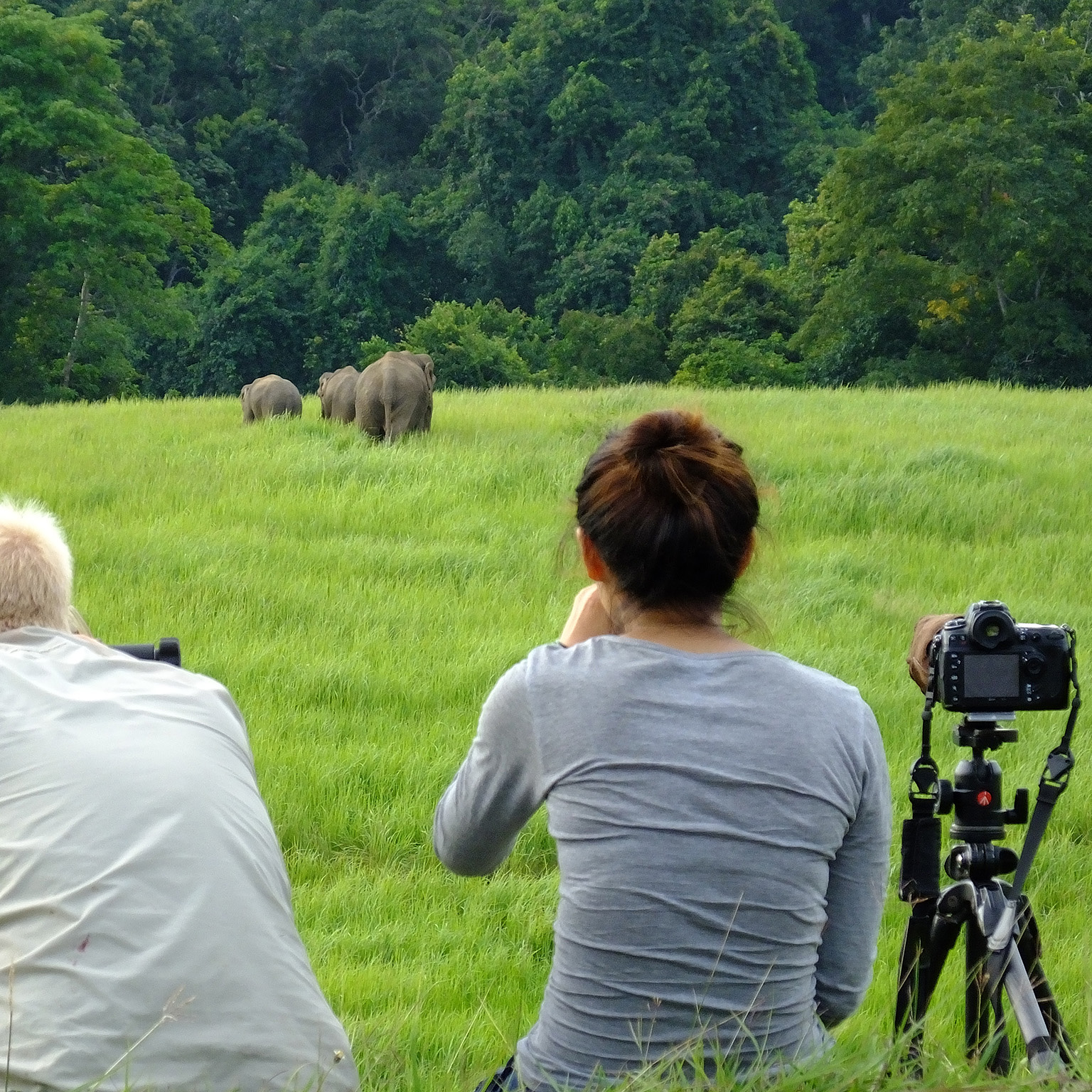
Private guided tours in Khao Yai
Book a private guided tour with your own guide to enjoy 1-3 days tour in Khao Yai National Park.
More infoGroup tours - Cheaper group tours with up to 10-12 people can be arranged on arrival to various hotels or from tour operators in the area. These tours are not flexible, following a strict itinerary.
Private wildlife tours - The best way to explore the park is by a private tour where no others will join you, flexible and can be adapted to your needs. The most popular tour options are;
Our other tour packages for photography and bird watching can be found on our guided tours pages or accessed from the main navigation.
Taxi from Bangkok
A single trip from any hotel/airport in Bangkok to a hotel north of Khao Yai costs from 2,300 Baht up. The trip takes around 2h 15 mins to 2h 30 mins in good traffic.
It is possible to book full day taxi service to attractions outside the park north of Khao Yai, to wineries, theme parks, farms, shopping places, etc. The most popular attractions are; PB Valley (winery), GranMonte (Winery), Primo Piazza (domestic animals), Palio Khao Yai (theme park), Farm Chokchai (cattle farm), The Chocolate Factory, Rai Maneesorn (sunflower blooming in December) and many others.
For more detail or online booking of private transportation visit our taxi details page;
- Taxi | Bangkok to Khao Yai, from 2,300 Baht
- Taxi | Pattaya to Khao Yai, from 3,500 Baht
Public transportation to Pak Chong and north of Khao Yai
For information about how to get to Pak Chong and hotels north of Khao Yai from Bangkok please visit “Get there & Stay” section of Khao Yai National Park pages.
Entrance fees & opening times
The park is open 6 am to 6 pm everyday all year round, vehicles already inside the park can leave on late hours.
As of September 2022, the entrance fees for Khao Yai National Park are increased back to 400 Baht for adults and 200 Baht for children 3-14 years old. Thai citizens pay 40 Baht for adults and 20 Baht for children. When camping or staying in one of the park accommodations inside the national park, the entrance tickets will be valid for 3 days, otherwise the entrance tickets are valid for one day only.
As of March 2015, Thai driving licence, work permit or student card holders can't get in for Thai price.
Activities
The main activities in the park are; hiking, wildlife watching, visiting waterfalls & viewpoints and camping.
The visitor center area is a good spot to get some quick information and start a day trip.
The best way for finding animals is via an experienced guide, by diving deeper into the jungles of Khao Yai. It is also possible to find some common animals along the roads or around the visitor center and campsites. While driving around, it is good to have the car windows open so that gibbon chattering can be heard, making it easy to locate them by call. There are also few saltlicks along the roads to attract bigger mammals such as elephants, gaurs (rare), deer and boars. Northern pig-tailed macaques are almost impossible to miss if enough driving is done.
The bird spots are all over the park, moving around the park with car windows open will give opportunity to locate some hot spots by bird calls, often around fruiting fig trees.
There are many trail options from 800 meters up to 8 km long. Most of the trails are northwest from the visitor center area which are all circular trails. The very short circular trail behind the visitor centre area and a new about 2 km long trail called "Thai-American Friendship Trail" are the only trails in the park that doesn't require a guide. Any other trail must be accompanied by a guide. There are also some longer routes that require guides for up to 3 days hiking. To see some of the popular trails, please open the map of Khao Yai from this page.
Although the park is very popular among the local tourists, the majority of the local tourists prefer a picnic style stay at camping grounds and only visit the waterfalls and viewpoints, meaning most of the trails aren't that busy.
There are a number of waterfalls in the park, most of them easily accessible by vehicles combined with a short walk. Haew Narok Waterfall in Khao Yai is one of the highest and most impressive waterfalls in the country. The jump scene from The Beach movie starring Leonardo Dicaprio is from Haew Suwat Waterfall located 8 km east from the visitor center.
Stay & eat
Hotels
Plenty of hotels and guesthouses can be found right outside the park boundaries. Some of the popular ones are listed on the “Get there & Stay” section of our Khao Yai pages. Listed hotels there are ideal for pick up by various tour operators. Some hotels in the area don't like the tour operators to pick up their guests and should be avoided for flexibility. It is wide to consult with the tour operator when booking any hotel in the area.
Camping
There are two main campsites in the park; Lam Ta Khong Campsite and Pha Kluai Mai Campsite. Tents and sleeping gear can be rented from each campsite and can’t be booked in advance. See “Attractions of Khao Yai” further below for more info.
Park accomodations
There are accomodations in two different spots inside the national park. They cost 800 Baht (2 people), 2,400 Baht (8 people) and 9,000 Baht (20 people).
The accommodations can only be booked through the DNP website in advance. As the money transfer must be done within 2 days and the fact that it takes a longer time with transfer from abroad, it is only possible to book from within Thailand. Payments can be done at 7-Eleven convenience stores or banks.
Keys for the booked accommodation can be picked up at the visitor center inside the park.
Eat
There are several restaurants, cafés and food stalls in the park. A restaurant, café and several food stalls can be found right opposite the visitor center. Both campsites have a restaurant and a café each, open from early hours around 6 to 8 am in the morning until 3-6 pm depending on how busy the campsites are. There is one more restaurant at Haew Narok Waterfall on the south side of the park.
Mobile reception
There is good mobile reception in the park nowadays but is limited to three providers; AIS, True and DTAC. Along the main road inside the park, the mobile reception may be gone at some stretches of the road. The mobile reception is quite good around the visitor center, the park accommodations, the campsites and all of the major attractions.
Khao Yai on Facebook
If you have questions regarding Khao Yai National Park you can't find answers for or would like to share your photos/experience, feel free to join Khao Yai group on Facebook.
Phone(s)
You are recommended to ask a Thai speaking person to call on your behalf.
- +66 (0)8 6092 6529 (visitor center)
- +66 (0)8 6092 6531 (checkpoint north)
Attractions of Khao Yai
Visitor Center
Situated around 14 km into the park from the northern entrance, it is a nice and open area worth stopping and looking around. There is a restaurant, several food stalls, toilets and various buildings in the immediate vicinity of the visitor center.
Few of the very common animals of the park are seen around the visitor center almost daily; macaques, sambar deer, various interesting birds and many more. Sadly, some visitors release their turtles in the river stream behind the visitor center. People often see turtles sunbathing on rocks, species that normally not found in the park or in the country.
There are several interesting trails starting from the visitor center, others just a couple of kilometers off. Most of the trails require a guide to walk. The 800 meters long circular trail behind the visitor center is the only trail in the park free to walk without any guide. For other trails, please click the "Show on map" link.
Although the area around the visitor center is known to be a bit busy, it is one of the best places in the park to spot some common birds. Kingfishers and hornbills are frequently seen.
Trails
There are seven official trails of which most must be accompanied by either a guide or a ranger (if available). Guides can be arranged via various tour operators (or this website), rangers must be arranged earliest in the morning for availability. The shortest trail is a 800 m long circular trail behind the visitor center, the longest one is the 8 km, an one way trail that starts behind the visitor center and ends at Haew Suwat Waterfall. All of the official trails are numbered nowadays, it is best to refer to them by the numbers to avoid misunderstandings.
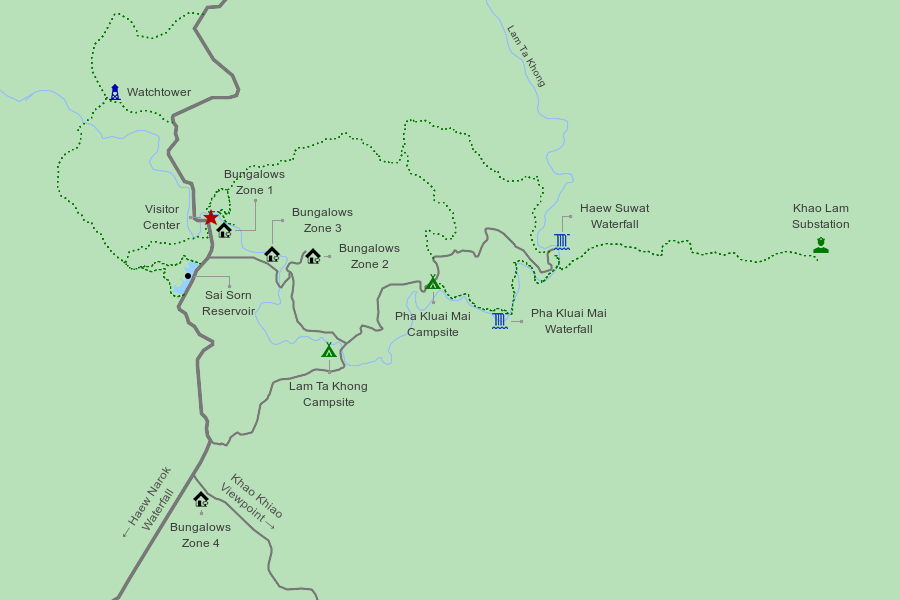
Trail #1 | Visitor Center - Kong Kaeo Waterfall
It is the shortest trail of the all seven official trails. In the brochure from the park it is mentioned to be 1.2 km, but the circular bit is about 800 meters, at some point the trail branches off to a small waterfall called Kong Kaeo Waterfall, with that bit included, it becomes 1.2 km long. The habitat along the trail is mostly a bamboo mixed forest.
Trail #2 | Pha Kluai Mai Waterfall - Haew Suwat Waterfall
About a 3 km long trail between Pha Kluai Mai Campsite and Haew Suwat Waterfall. This trail follows Lam Ta Khong Stream, a smaller waterfall called Pha Kluai Mai Waterfall is along the path. There used to be a crocodile living at one spot in the river but hasn't been seen for a while, possibly dead. There are no more crocodiles in the park. The trail must be accompanied by a guide or ranger.
Trail #3 | Km 33 - Nong Pak Chi Tower
Also called the "km 33-trail", it is a 3.3 km long circular trail that starts either from Nong Pak Chi Tower about 2 km north from the visitor center, or another 1.5 km further north along the main road. The trail must be accompanied by a guide or ranger.
Trail #4 | Dong Tiew - Sai Sorn Reservoir
Information given about this trail on the brochure from the visitor center is very confusing. On the map, compared to Trail #7, it seems like about 1/3 in length, yet, it is informed that the trail length is longer, about 2.7 km (longer). This is because on the map from the brochure, the western end of this circular trail ends at western edge of the Sai Sorn Reservoir, but in reality it is further west. The trail is very confusing with multiple branches, not signposted well, it shouldn't be walked without a guide or ranger.
Trail #5 | Dong Tiew - Nong Pak Chi Tower
A very popular circular trail, about 5 km long. The trailhead is 2 km north from the visitor center, about 700 meters of the trail through a spacious grassland where elephants are seen from time to time. The bit of this trail until the grassland can be walked without a range, but the bit into the forest must be accompanied by a guide or a ranger.
Trail #6 | Visitor Center - Haew Suwat Waterfall
The longest of the official trails, about 8 km long. It starts from the visitor center and ends at Haew Suwat Waterfall. This trail must be accompanied by a guide or a ranger.
Trail #7 | Thai-American Friendship Trail
A recently opened new circular trail, about 2.7 km long. The trail starts from the main road at the north end of Sai Sorn Reservoir and ends at the same road south of the reservoir. The trail can be walked without a ranger or guide but not signposted well, there are several trails branches off, not obvious how to continue ahead.
Campsites
There are two campsites within the park boundaries, both with toilets, showers, parking spaces. Tents are available for rent from 250 Baht (2 people), accessories such as sleeping bags, pillows, blankets etc for 20-50 Baht each. The areas around both campsites are ideal for hiking.
When leaving the tents, macaques will visit them sooner or later. If the tent-doors are closed, monkeys may tear it apart. Campers are advised to leave the doors and any bags inside open. Any smaller bags or anything the monkeys may mistake for a food package should be left open. Macaques will only take away food or anything that clearly looks like a food container, they won’t bother about other items.
During the winter seasons November to February the night temperatures may fall down to 9-10 °C. Warm clothes are recommended for a convenient sleep, getting to the toilet in the night but also for early morning/late evening hiking or when using a motorbike.
Lam Ta Khong Campsite
It is the first campsite, about 6 km from the visitor center. There is a few hundred meters long short trail over the bridge north from the campsite which leads to some open grassland areas, very ideal for wildlife watching. Elephants do show up on the roads around the campsite from time to time. Malayan porcupines and civets visit this campsite every night, they can easily be found because their eyes get shiny when pointed with a flashlight. Please avoid pointing flashlights into animals eyes in close range, it may damage their eyes. Elephants are known to get aggressive when a flashlight is pointed at them.
The campsite has a minor restaurant which is not always open and often has only instant noodles like choices.
Pha Kluai Mai Campsite
It is located 3 km further east from the Lam Takhong Campsite. Tents, sleeping bags, pillows and mats are available for rent. Toilet/shower facilities are a bit better in this campsite. There is a restaurant at this campsite.
There is a 3 km trail along the water stream towards west from this campsite. The trail ends at the end of the main road a few hundred meters from Haew Suwat Waterfall. It is somewhere along this trail where the only crocodile of the park used to be found, it is assumed dead.
A bit downhill from the forest behind the first set of toilets on the north side of the campsite there is a "secret open space" where some exciting birds such as orange-headed thrush, white-rumped shama and Siberian blue robin can be seen frequently.
Porcupines and civets are common at the camping ground during the night.
Nong Phak Chi Wildlife Observation Watchtower
Situated 2.5 km northwest from the visitor center it has a very good view of surrounding grasslands. A salt lick and a pond found next to the watchtower which attracts some animals. Elephants show up here sometimes. The area around the watchtower has a network of trails.
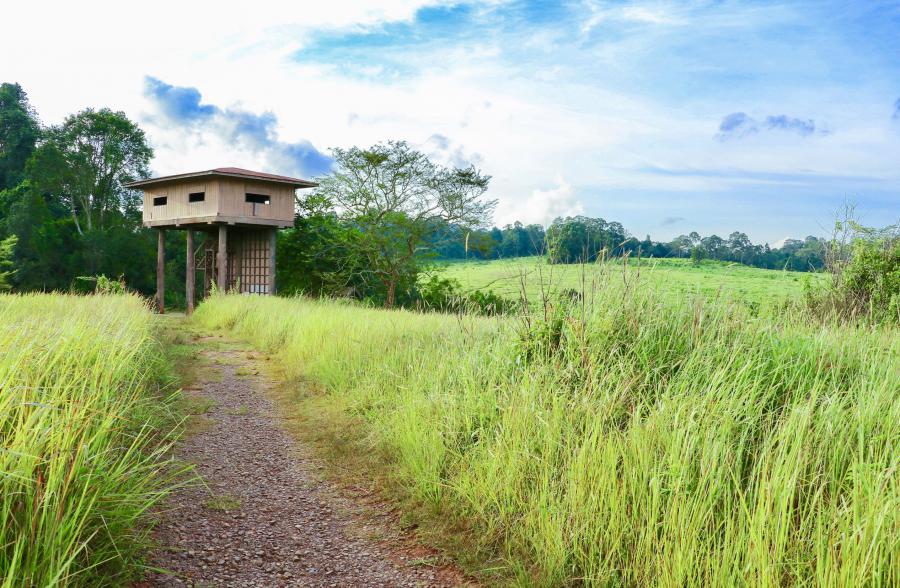
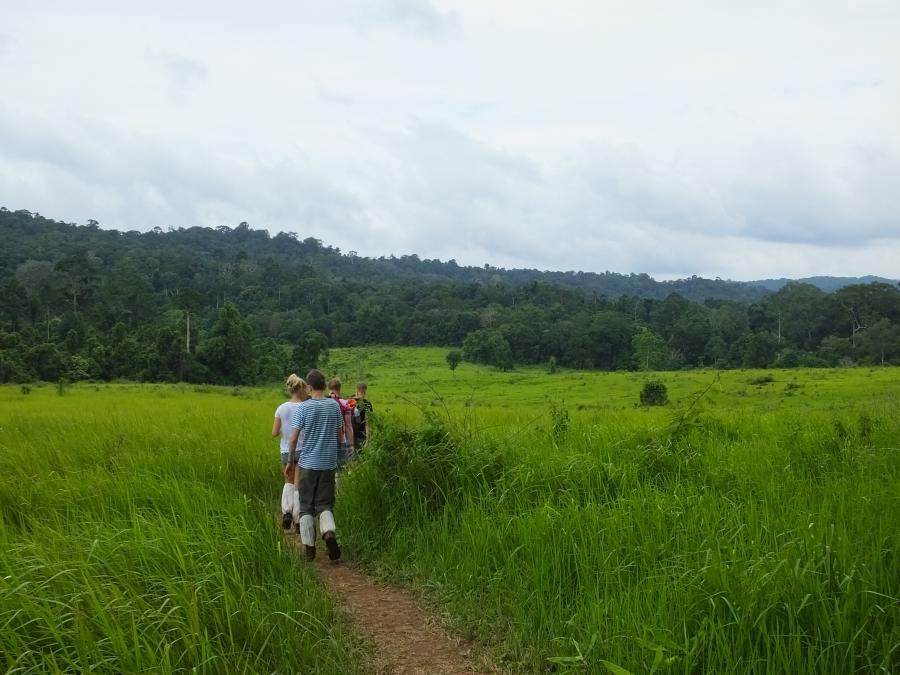
Waterfalls
Khao Yai has many waterfalls, most of them easily accessible by car combined with a short trail, some needs longer hiking with guide assistance.
Haew Narok Waterfall
With the highest one at 80 meters, this three tiered waterfall has a total altitude of 150 meters and is the biggest waterfall in Khao Yai National Park. It is situated approximately 10 km north from the southern gate. The waterfall is accessible by a 600 meters long trail from a car park next to the main road. There are toilets and a restaurant next to the car park.
Right before walking downstairs to the viewpoint there is a pavilion-ish rest area where a 600-800 meters long trail starts. The trail has no sign or any information. This trail will lead to a much better view point where the waterfall can be seen from a higher point for better landscape photography.
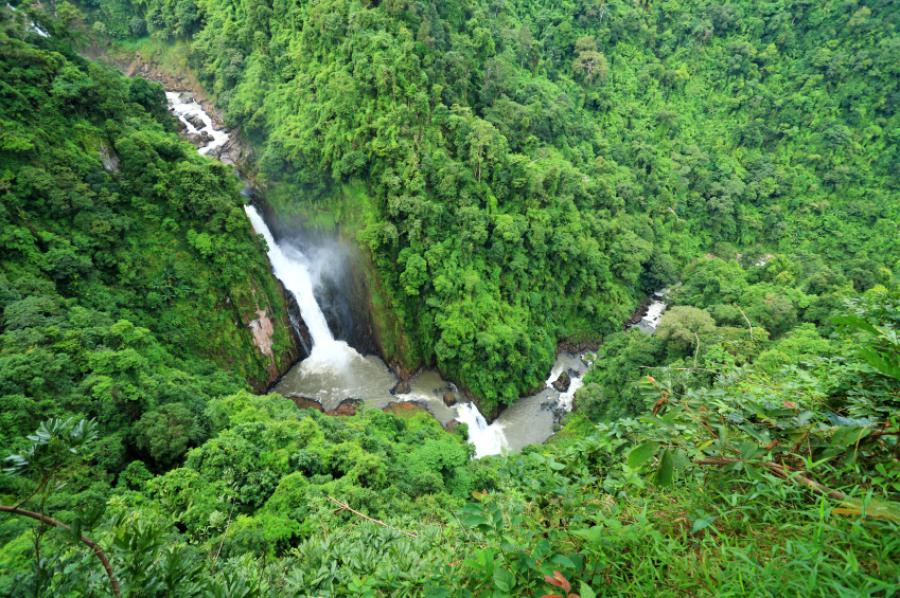
The short trail to the waterfall is a great place to find some birds, lizards, macaques and possibly elephants.
Back in October 2019, 11 elephants died at Haew Narok Waterfall while a herd of elephants possibly tried to rescue a calf from the strong stream of the river flowing down the main fall. Eight other elephants were also found dead at the same spot back in 1992.
Haew Suwat Waterfall
It is a 20 meters tall waterfall around 13 km from the visitor center. Many film scenes have been taken at this waterfall of which the jump scene from The Beach featured by Leonardio Di Caprio is the most famous one.
The waterfall is easily accessible by scooter or car, only a hundred meters off from it’s carpark area. There is a restaurant next to the car park which is regularly open.
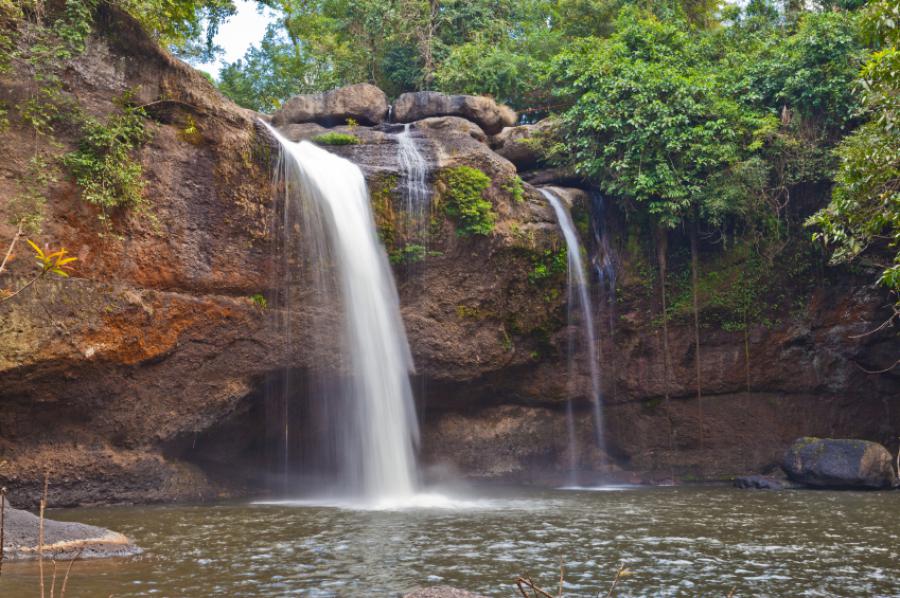
There is an alternative trail "hidden" somewhere in the open space next to the restaurant which leads to the top of the waterfall where the jump scene from The Beach was taken, less than 200 meters walk.
Haew Sai Fai Fall and Haew Pratoon Falls are two other smaller falls located only 700 to 1,000 meter further downstream north from Haew Suwat Waterfall, both need a guide to get to.
Pha Kluai Mai Waterfall
This smaller waterfall is along the 3 km long trail between Pha Kluai Mai Campsite and Haew Suwat Waterfall. The national park's only crocodile used to be here and could be seen nearly every day for years, but since October 2018, no one has seen it.
Nang Rong and Sarika Waterfalls
Both waterfalls are situated to the southeast of the park in Nakhon Nayok Province.
Viewpoint, north
4.5 km from the northern entrance, it is the first obvious stop for many tourists. The viewpoint is right next to the road, no hiking required. It has a good view of the surrounding areas.
Yod Khao Khieo Mountain
With 1,292 meters asl, it is the highest elevation in Nakhon Nayok Province. It is situated approximately 11 km from the visitor center, easily accessible by car or motorbike all the way to the top.
There are three good view points and several short trails along this road and at the top.
This road and the viewpoints are closed for visitors from 1st Jun until 30th September every year. The closure is to allow the forest to regenerate undisturbed.
Every few years, caused by landslides blocking the road, the viewpoint may occasionally get closed during the rainy seasons.
Pha Diew Dai Cliff
Also spelled as Pha Dieu Dai Cliff and few other variations, it is a viewpoint at 1,142 meters asl, accessible by a 600 meters long easy trail. Most of the trail is a wooden boardwalk.
The viewpoint here is the best in the park. Serows, silver pheasants and some other ground dwelling birds are quite common along the trail to this viewpoint.
Viewpoint #2
It is situated at the top of Yod Khao Kiew, a good view to the north. Elevation: 1,247 meters asl.
Viewpoint #3
Good view to the north. Elevation: 1,040 meters asl.
Khao Luk Chang Bat Cave
According to some sources around a million, according to others up to 3 million wrinkled-lipped bats live in this cave. During the sunset a long cloud of bats can be seen flying out from the cave for hours, creating a spectacular view. Some birds of prey are regularly seen feeding on bats by diving into the cloud.
It is located 4.5 km out from the north gate of the national park. See the marker on the map for the location of a trail leading to the cave. The cave is best to be visited with a stronger terrain vehicle.